a fourth, 'There was a scoundrel.' Does not this give cause for fear ? "
Contemporaneously with Ssu-ma Kuang lived CHOU TuN-I (1017-1073), who combined the duties of a small military command with prolonged and arduous study. He made himself ill by overwork and strict attention to the interests of the people at all hazards to himself. His chief works were written to elucidate the mysteries of the Book of Changes, and were published after his death by his disciples, with commentaries by Chu Hsi. The following short satire, veiled under the symbolism of flowers, being in a style which the educated Chinaman most appreciates, is very widely known :
" Lovers of flowering plants and shrubs we have had by scores, but T'ao Ch'ien alone devoted himself to the chrysanthemum. Since the opening days of the T'ang dynasty, it has been fashionable to admire the peony ; but my favourite is the water-lily. How stain- less it rises from its slimy bed ! How modestly it re- poses on the clear pool an emblem of purity and truth ! Symmetrically perfect, its subtle perfume is wafted far and wide, while there it rests in spotless state, something to be regarded reverently from a dis- tance, and not to be profaned by familiar approach.
" In my opinion the chrysanthemum is the flower of retirement and culture ; the peony the flower of rank and wealth ; the water-lily, the Lady Virtue sans pareille.
"Alas! few have loved the chrysanthemum since T'ao Ch'ien, and none now love the water-lily like myself, whereas the peony is a general favourite with all mankind."
�� �
